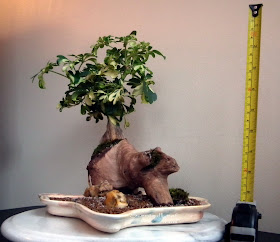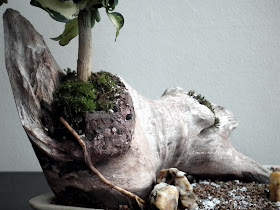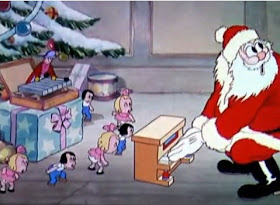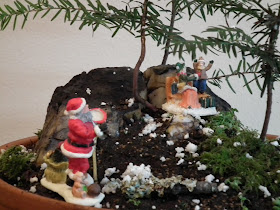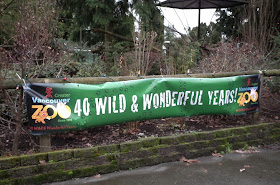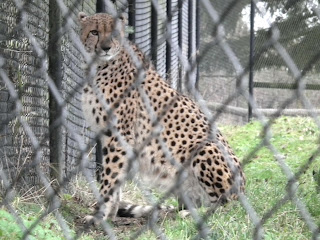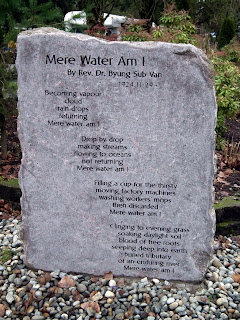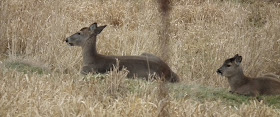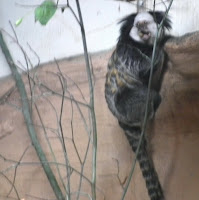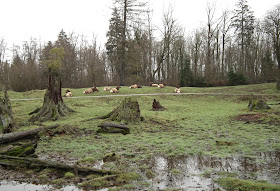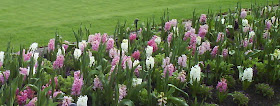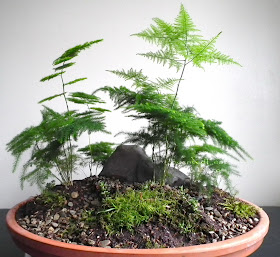One of the plants which we are growing indoor is Schefflera plant with variegated leaves. It is a very showy tropical plant (named also Umbrella Plant or Gold Capella) very easy to propagate with leaf cuttings or by air layering.
Our last project was to create a miniature landscape: driftwood and Schefflera Arboricola
Dwarf Umbrella Tree - is a smaller version of Schefflera plant with smaller variegated leaves . The leaves that are growing in clusters (only 2-5 cm) are arranged like spokes on a umbrellas and have creamy blotches on them. We love more this smaller variety instead of the common Schefflera plant (Schefflera Actonophylla: larger leaves - around 20 cm, and higher habit - more than 4 feet).
I know... it is not scented nor edible, but is nice and easy to work with it, especially in winter season, when most of the outdoor plants are in dormancy.
Initially, the plant was grown for few months in a small plastic pot, then pruned and re-potted it in this massive arching hollowed driftwood to create a theme that suggest a Hawaiian beach.
One long root was passed over the left side of the driftwood. We decided to keep it for esthetically reasons and also to help feed the plant.
We added Turface and white sand (surf like) in the tray and the plant is watered twice a day - it likes water. If the plant is under-watered its foliage turns yellow and begin to curl (soon will drop the leaves, too).
For decorative purposes for this indoor arrangement (miniature craft with potted plants) we also used few calcareous rocks fixed with clay in the tray, and some moss - and is ready for show. Enjoy it.
Pages
▼
Thursday, December 30, 2010
Wednesday, December 22, 2010
The night before Christmas
The Christmas Eve is almost here. For me the true meaning of the winter Holidays is to get home and to bind together my loved ones around Christmas tree. I'm waiting for Santa watching old movies, listening playfulness Christmas songs and enjoying (for sure) being cut off from the everyday problems. Maybe next poem was just my imagination, but it is the projection of my thoughts written by me when I was asleep in magic Christmas dreams.
The night before Christmas
Tonight I'll see again a winter's movies inspired by Santa's fairy-tales
And I'll recount the story of the Christmas and the mirage of the Holly Grail.
Although it's not midnight, through snowflakes, the darkness will unveil
The Santa Claus arrival, friendly "ghost" projected on the walls with so many details.
I love to be present at his triumphal arrival, it is such a fantastic silvery-sight.
The Angels sang Corals on my street. Is the Christmas Eve, and in this night
I listen at the chimney their song when I'm waiting to see in the moonlight
How Santa is climbing over the house and his sledge carried by deers stops from its flight.
The Christmas tree lit magically the Santa's way when he tries to go unseen
From the chimney, passing the roaring fire. For me is magic, for him is routine
To enter the room and to walk in so quiet. His face enlighten by smile should be seen
When puts presents under tree. His presence makes me asleep in Christmas dreams.
Well, as I said... it is time to see some films of the "classic" era of the 1930s and 1940s - movies like "Santa's workshop (1932) have something that always and forever capture all the people (children or older) and these days they don't make movies like these anymore.
Give a try to "A Christmas Carol (1935)" and for almost 80 minutes you'll feel like you read the Charles Dickens' book (and also you compare it with the Disney's animation 2009 version). Or if you are sentimental and want to laugh, try to find "We're no Angels" with Humphrey Bogart (1955) or "The Night before Christmas(1933)".
Alternate those movies with Christmas Corals or magical classical songs like: "Ave Maria" by Schubert , or "Ave Maria, Dolce Maria" song written by Pavarotti, featured in stunning "The Three Tenors" recitals of Jose Carreras, Placido Domingo and Luciano Pavarotti (1999, Vienna):
and I'm sure you'll have a great Holly Night with magic "Christmas Jingle Bells".
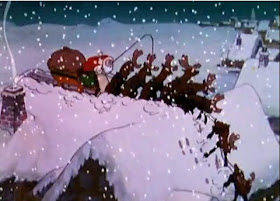 |
| The night before Christmas, 1933 |
The night before Christmas
Tonight I'll see again a winter's movies inspired by Santa's fairy-tales
And I'll recount the story of the Christmas and the mirage of the Holly Grail.
Although it's not midnight, through snowflakes, the darkness will unveil
The Santa Claus arrival, friendly "ghost" projected on the walls with so many details.
I love to be present at his triumphal arrival, it is such a fantastic silvery-sight.
The Angels sang Corals on my street. Is the Christmas Eve, and in this night
I listen at the chimney their song when I'm waiting to see in the moonlight
How Santa is climbing over the house and his sledge carried by deers stops from its flight.
The Christmas tree lit magically the Santa's way when he tries to go unseen
From the chimney, passing the roaring fire. For me is magic, for him is routine
To enter the room and to walk in so quiet. His face enlighten by smile should be seen
When puts presents under tree. His presence makes me asleep in Christmas dreams.
Well, as I said... it is time to see some films of the "classic" era of the 1930s and 1940s - movies like "Santa's workshop (1932) have something that always and forever capture all the people (children or older) and these days they don't make movies like these anymore.
Give a try to "A Christmas Carol (1935)" and for almost 80 minutes you'll feel like you read the Charles Dickens' book (and also you compare it with the Disney's animation 2009 version). Or if you are sentimental and want to laugh, try to find "We're no Angels" with Humphrey Bogart (1955) or "The Night before Christmas(1933)".
Alternate those movies with Christmas Corals or magical classical songs like: "Ave Maria" by Schubert , or "Ave Maria, Dolce Maria" song written by Pavarotti, featured in stunning "The Three Tenors" recitals of Jose Carreras, Placido Domingo and Luciano Pavarotti (1999, Vienna):
and I'm sure you'll have a great Holly Night with magic "Christmas Jingle Bells".
Thursday, December 16, 2010
Potted Scenery - Santa Claus is coming to town!
One friend of mine asked me to make a potted scenery having "Santa Claus is Coming To Town" theme. He intend to give this small attention to his son (is 7 years old) as a reward for his hard working (he has learned a lot of poems and songs waiting for Santa Claus to come!) We were talking many times about the importance to teach your kid to love nature using a joyful miniature garden. What a perfect gift for small hands, sponge-brains and balloon-hearts.
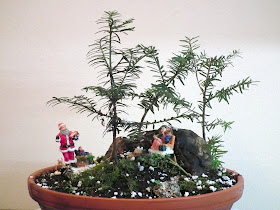
This brings back childhood memories! Fred Astaire, Ella Fitzgerald, Ray Charles, Mariah Carey, Frank Sinatra, Andreea Bocelli... so many darn good storytellers and singers charmed my Christmas Nights with wonderful stories or singing " Santa Claus is Coming To Town" (the hit written by Fred Coots and Haven Gillespie).
You better watch out
You better not cry
Better not pout
I'm telling you why
Santa Claus is coming to town
He's making a list
He's checking it twice;
He's Gonna find out
Who's naughty and nice
Santa Claus is coming to town
He sees you when you're sleeping
He knows when you're awake
He knows if you've been bad or good
So be good for goodness sake!
O! You better watch out!
You better not cry
Better not pout
I'm telling you why
Santa Claus is coming to town
Santa Claus is coming to town
Combing the town for some well designed miniature figurines with Santa Claus, I found this group (around 5 cm high) Santa and a small kid sitting on a bench with his mother, or should I say ... joyful jumping on a bench:
-Mom, Look, It's here, It's here !!!
The "human presence" it is balanced perfectly by the dimension of the tray, 24 cm, and the small Yew trees.
Yew (Taxus canadensis ) is a conifer native to North America, very common in Vancouver area, which grow as a sprawling shrub with dark green leaves. I thought it would be appropriate to use three conifers for this small tray landscape (known also as penjing, or saikei) with the theme of Santa Claus's arrival.
I used two big rocks, positioned next, rear-right centered, to give the impression of viewing a peaceful highland, perfect spot for a sitting bench.
OK,, it is not the classic ... warm home, hot chocolate, Christmas tree, Santa coming down the chimney ... is more like ... Mam' , why-we-cannot-wait-for-Santa-here?!,... type of setting. You know ... you've done that too.
One of the trees with a sinuous trunk was planted at the interference of the rocks covering the sitting bench with its shadow.
Santa Claus is coming from the left side, the foreground being created by the bigest Yew planted in center-left of the tray. I covered with moss, accent plants and a small stick on which lichens grown in abundance, then I spread a layer of white perlite to make it snow.
Was kind of a challenging project but I am proud of the end result.
Click & drag to interact with the next 3D object movie.
If zoomed in, you can hold the SHIFT key to move the image with the mouse.
Pssst! Santa Claus is coming to town! It's almost here!

This brings back childhood memories! Fred Astaire, Ella Fitzgerald, Ray Charles, Mariah Carey, Frank Sinatra, Andreea Bocelli... so many darn good storytellers and singers charmed my Christmas Nights with wonderful stories or singing " Santa Claus is Coming To Town" (the hit written by Fred Coots and Haven Gillespie).
You better watch out
You better not cry
Better not pout
I'm telling you why
Santa Claus is coming to town
He's making a list
He's checking it twice;
He's Gonna find out
Who's naughty and nice
Santa Claus is coming to town
He sees you when you're sleeping
He knows when you're awake
He knows if you've been bad or good
So be good for goodness sake!
O! You better watch out!
You better not cry
Better not pout
I'm telling you why
Santa Claus is coming to town
Santa Claus is coming to town
Combing the town for some well designed miniature figurines with Santa Claus, I found this group (around 5 cm high) Santa and a small kid sitting on a bench with his mother, or should I say ... joyful jumping on a bench:
-Mom, Look, It's here, It's here !!!
The "human presence" it is balanced perfectly by the dimension of the tray, 24 cm, and the small Yew trees.
Yew (Taxus canadensis ) is a conifer native to North America, very common in Vancouver area, which grow as a sprawling shrub with dark green leaves. I thought it would be appropriate to use three conifers for this small tray landscape (known also as penjing, or saikei) with the theme of Santa Claus's arrival.
I used two big rocks, positioned next, rear-right centered, to give the impression of viewing a peaceful highland, perfect spot for a sitting bench.
OK,, it is not the classic ... warm home, hot chocolate, Christmas tree, Santa coming down the chimney ... is more like ... Mam' , why-we-cannot-wait-for-Santa-here?!,... type of setting. You know ... you've done that too.
One of the trees with a sinuous trunk was planted at the interference of the rocks covering the sitting bench with its shadow.
Santa Claus is coming from the left side, the foreground being created by the bigest Yew planted in center-left of the tray. I covered with moss, accent plants and a small stick on which lichens grown in abundance, then I spread a layer of white perlite to make it snow.
Was kind of a challenging project but I am proud of the end result.
Click & drag to interact with the next 3D object movie.
If zoomed in, you can hold the SHIFT key to move the image with the mouse.
Pssst! Santa Claus is coming to town! It's almost here!
Winter Tour at Greater Vancouver Zoo
This weekend we had a tour at Great Vancouver Zoo. Actually we had 2 rides, one entire tour by walking and the second, with "Santa's train", around the whole zoo.

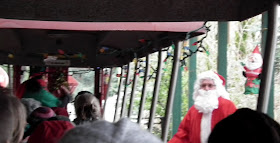
We took a a lot of pictures, mostly for the animals though. Although we were talking about this trip since the beginning of this year, maybe because the Greater Vancouver Zoo is not in the city, we let days pass, each time finding something "more important" to do (as Jerry Lewis said once: " If the zoo wants you, let them come and get you"). So we went several miles East, near the town of Aldergrove, because we really want to visit Vancouver's Zoo when celebrates 40 years.
We were thinking somehow with skepticism about visiting Aldergrove ZOO in the winter, as we already know that many animals are protected indoor by winter cold, but even the weather was not so warm, we find a great advantage of our late visit: there are fewer people to block our view.
I was feeling like an explorer, the Greater Vancouver Zoo did a nice job of providing large habitats for the animals under their care. After we passed by the entrance building (which looks very cheerful) we had a lot of fun watching wild birds (Flamingo, Emu, Sandhill Crane) and animals when playing on the zoo trails.

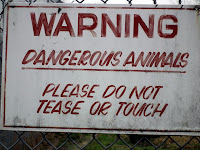
Warning signs were everywhere, and like every time when I visited a ZOO, it was kind of weird experience of seeing dangerous animals in the wild.
We was experiencing kind of shiver through our heart when we saw Lions, Siberian Tiger and Cheetah watching us from behind bars with their sharp sight.
Near entrance we contemplate the poem ”Mere Water Am I” by Dr. Rev. Byung Sub Van's (Korean-Canadian writer and theologian), inscribed on a stone as a public art poetry-rock.
"Becoming vapour
cloud
rain drops
returning
Mere water am I
Drop by drop
making streams
flowing to oceans
not returning
Mere water am I
Filling a cup for the thirsty
moving factory machines
washing workers mops
then discarded
Mere Water am I
Clinging to evening glass
soaking daylight soil
blood of tree roots
seeping deep into earth
buried tributary
of an enduring river
Mere water am I"
Many interesting things about some of ZOO's animals were told us by Santa and his apprentice, good narrators who detailed us interesting little thingy about them. We spent a lot of time supervising Bambi, (one favorite Disney little friend) and his white-tailed family.
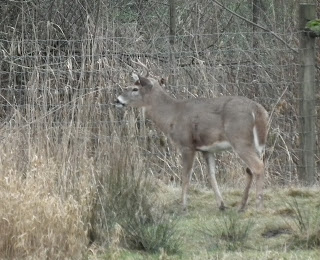
We did not interact with some of the animals, as Rhino and Giraffe, because they were protected indoor by winter cold. We saw them through huge windows and we were impressed by their size.
The Vivarium animals were hidden in their glass-boxes, many of species being mixed in same space, perhaps to give them a richer life feeling: Gecko and Iguana were climbing on driftwoods, Lizard Saharan Spiny was standing behind a rock, turtle was sitting motionless on top of the crocodile, (unlike them) the playfully Marmosets never sit, making extremely hard to take them a picture.
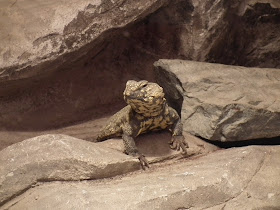
Amazing were the pristine wilderness landscapes mixed together with animals - some of them look really breathtaking - and maybe I'll use them as inspiration for some future miniature landscapes.
After all great time spent and the amazing pictures taken there, visiting Vancouver Zoo is a fun and interesting experience in any season.
Wednesday, December 15, 2010
Forcing Hyacinthus Orientalis bulbs for Christmas Days
I love to have in Christmas days some showy, highly-fragrant flowers in the midst of all this winter. With charming elegance, multicolor flowers and wonderful fragrance, Hyacinth is an overlooking flowering plant easy to grow indoor. Hyacinthus Orientalis plants with small bell-shaped flowers looking like small starfish belonging to lily family (Liliaceae), are very popular in Mediterranean area (my native area), being also named: The Dutch, Common Hyacinth,Garden Hyacinth, Zambila or Iacint.
 Hyacinths were grown in Europe in the time of the Greeks and Romans. Homer reminded their flowers in his Odyssey: "... Athene, the daughter of Zeus, made him greater and more mighty to behold, and from his head caused deep curling locks to flow, like the hyacinth flower." Homer, Odyssey.
Hyacinths were grown in Europe in the time of the Greeks and Romans. Homer reminded their flowers in his Odyssey: "... Athene, the daughter of Zeus, made him greater and more mighty to behold, and from his head caused deep curling locks to flow, like the hyacinth flower." Homer, Odyssey. and accordingly to the Greek Mythology, the Hyacinth flower was made by Apollo from Hyacinthos's spilled blood , in the memory of the Hyacinthos, son of Amyclas, a beautiful youth loved by Apollo and Zephyr. A small fragment of Apollo's melodramatic speech when he did this:
" And evermore shall thou live as a flower that will speak to the hearts of men of spring, of everlasting youth—of life that lives forever." Greek Mythology
Usually in garden, they start blooming in the beginning of spring if are planted in sunny locations. After the blooming season, at the beginning of July, I dag out the hyacinth bulbs, then I kept them indoor (at 22-25 °C) for few weeks. The bulbs should be planted in flowerbeds at the beginning of September, if you want them to decorate your garden in March.
 |
| Sprouted Hyacinth Bulbs |
 |
| Hyacinth bulbs |
 The naturally spring-flowering bulbs could be tricked to behave as gone through a cold winter (keeping for 12-13 weeks in complete darkness under the temperature of +5°C) , then, after hyacinth bean takes roots and produce sprouts 2-2.5cm tall, brought them in a cool (better 20°C) and well enlightened place in the house. After 2-3 weeks they will flower and once the flowers begin to open, your room will be filled with a pleasant fragrance.
The naturally spring-flowering bulbs could be tricked to behave as gone through a cold winter (keeping for 12-13 weeks in complete darkness under the temperature of +5°C) , then, after hyacinth bean takes roots and produce sprouts 2-2.5cm tall, brought them in a cool (better 20°C) and well enlightened place in the house. After 2-3 weeks they will flower and once the flowers begin to open, your room will be filled with a pleasant fragrance.Well, I began this process in September with few bulbs, in order to have in my house blooming Hyacinths throughout Christmas season. I kept the bulbs in a black plastic box in the refrigerator, spraying them twice a week to keep the moisture level inside the box. Now, the "spring arrived" for them, and I was looking after my old bulb pots to place into them the sprouted hyacinths. Hope I'll have fragrant flowers in Christmas days.
Tuesday, December 14, 2010
Saikei with Asparagus Fern
Well, the Christmas Holiday is almost here and as usual, before Christmas Holiday, teachers and kids organize different thematic parties: about Christmas, Santa, New Year Eve, human history, mythology, wild nature or animals.
We realized a living miniature garden / Saikei with asparagus fern, accent plants, moss and ground cover grasses (we used also immature plants in this tray landscape) for one of the classes of the school from neighborhood. The school show theme was: "Mountain plateau in the shadow of forest".
On this occasion, for this living mini-garden we choose a big rounded unglazed tray (36 cm diameter). We covered the bottom of the tray with base soil and placed one big stone in the rear-center of the tray (you can see the detailed schema of composition).
The rock was collected from the pristine wilderness of Harrison River in one of our weekend-trip and is a grayish mountain stone that slopes gracefully and resembles a mountain. Its rough surface induces the age impression and its small crevices suggest were created by rapidly moving waters.
 We planted seven Asparagus Fern plants (3 big used as foreground view and 4 small plants used as a distant view) and formed three mounds (right-foreground, left-foreground and immediately behind left-foreground mound) separated by gravel sliding (gravel were also added around mountain slopes).
We planted seven Asparagus Fern plants (3 big used as foreground view and 4 small plants used as a distant view) and formed three mounds (right-foreground, left-foreground and immediately behind left-foreground mound) separated by gravel sliding (gravel were also added around mountain slopes).
We chosen Asparagus Fern because they look like a grove of trees and suggest many trunks growing from a single root system. Asparagus fern (named also Asparagus Densiflorus, Sprenger's Asparagus, Asparagus Sprengeri) is a weed native to South Africa from Liliaceae family used often as an ornamental plant because its delicate, feathery foliage that looks like a fern and can reach 45-60 cm high.
Asparagus fern is a low maintenance plant that can be grown quite easily indoor (the plant prefers bright light, though it can tolerate low light conditions as well).
We considered the overall effect of the entire composition and tried to emphasize the characteristics of gravel, accent plants, moss and ground-cover plants when covered the whole surface of this Saikei.
This custom tray landscape was made considering the suggestions of the teacher who organized the show and was very appreciated by audience - children, teachers and parents.
Click & drag to interact with the next 3D object movie.
If zoomed in, you can hold the SHIFT key to move the image with the mouse.
We realized a living miniature garden / Saikei with asparagus fern, accent plants, moss and ground cover grasses (we used also immature plants in this tray landscape) for one of the classes of the school from neighborhood. The school show theme was: "Mountain plateau in the shadow of forest".
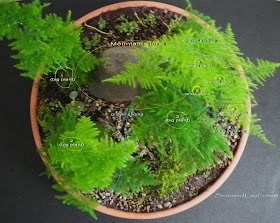 |
| Saikei / miniature garden with seven asparagus fern plants - schema |
On this occasion, for this living mini-garden we choose a big rounded unglazed tray (36 cm diameter). We covered the bottom of the tray with base soil and placed one big stone in the rear-center of the tray (you can see the detailed schema of composition).
The rock was collected from the pristine wilderness of Harrison River in one of our weekend-trip and is a grayish mountain stone that slopes gracefully and resembles a mountain. Its rough surface induces the age impression and its small crevices suggest were created by rapidly moving waters.
 We planted seven Asparagus Fern plants (3 big used as foreground view and 4 small plants used as a distant view) and formed three mounds (right-foreground, left-foreground and immediately behind left-foreground mound) separated by gravel sliding (gravel were also added around mountain slopes).
We planted seven Asparagus Fern plants (3 big used as foreground view and 4 small plants used as a distant view) and formed three mounds (right-foreground, left-foreground and immediately behind left-foreground mound) separated by gravel sliding (gravel were also added around mountain slopes).We chosen Asparagus Fern because they look like a grove of trees and suggest many trunks growing from a single root system. Asparagus fern (named also Asparagus Densiflorus, Sprenger's Asparagus, Asparagus Sprengeri) is a weed native to South Africa from Liliaceae family used often as an ornamental plant because its delicate, feathery foliage that looks like a fern and can reach 45-60 cm high.
Asparagus fern is a low maintenance plant that can be grown quite easily indoor (the plant prefers bright light, though it can tolerate low light conditions as well).
We considered the overall effect of the entire composition and tried to emphasize the characteristics of gravel, accent plants, moss and ground-cover plants when covered the whole surface of this Saikei.
This custom tray landscape was made considering the suggestions of the teacher who organized the show and was very appreciated by audience - children, teachers and parents.
Click & drag to interact with the next 3D object movie.
If zoomed in, you can hold the SHIFT key to move the image with the mouse.
Qianlong Porcelain Bulb Pot
These days I was looking after my old bulb pots to place into them the sprouted bulbs started to grow in September. I have few Chinese bulb pots and for first time since I have had them, I was looking to translate their marks.
My surprise was to discover that one of my favorite pots is a Qianlong porcelain bulb pot from China, perhaps made somewhere at the beginning of the 20th century.
On its bottom is marked with a red "Qianlong nian zhi" mark in Kaishu / normal script style - a present-day regular script (not in zhuanshu / archaic seall script - which is drawing). This mark should be translated as "Made (or make?) for Qian Long Emperor".
Qian Long Emperor (25 September 1711 – 7 February 1799) was the fifth emperor of the Manchu-led Qing Dynasty who rule over China for 60 years (1735-1796). The Qian Long Emperor was a major patron of the arts and was a passionate poet and essayist. Pottery, ceramics and particularly applied arts flourished during his reign. During his reign was realized the Siku Quanshu, a catalogue of all important works on Chinese culture. In his collected writings are listed over 40,000 poems and 1,300 prose texts, making him one of the most prolific writers of all time, his name being linked physically and intellectually with ancient artistic tradition. He regularly added poetic inscriptions to the paintings or ceramic objects of the imperial collection, following the example of the emperors of the Song dynasty and the literati painters of the Ming.
My bulb pot looks almost new, with no cracks or chips. It is not a fake, it was made with quality and style in the 20th century as one from the Qianlong period. Its dimensions are: width 24 cm, depth 1.5 cm and height 7,5 cm. It is a rectangular porcelain bulb dish painted with traditional Chinese landscape imagery showing on two sides tranquil country lake scenes.
These pots, with no drain holes, usually were used as decorative dishes for forcing bulbs to bloom indoor. Some people used them as a bonsai pot, too.
On the other two sides are inscribed two Chinese poems between other red marks. I wasn't so lucky to find them on the internet, so I did not know how to translate them (yet).
I'm sure this year bulbs will not grow in this Chinese Qianlong bulb pot because I still research about it - I am wandering when was made it and what's the meaning of poems written on its sides.
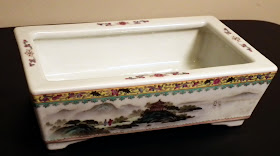 |
| Qianlong bulb (bonsai) pot made of porcelain |
My surprise was to discover that one of my favorite pots is a Qianlong porcelain bulb pot from China, perhaps made somewhere at the beginning of the 20th century.
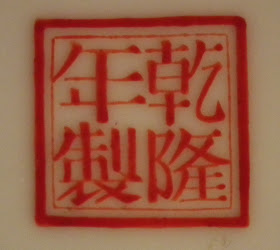 |
| Qianlong bulb pot mark in kaishu normal script style |
On its bottom is marked with a red "Qianlong nian zhi" mark in Kaishu / normal script style - a present-day regular script (not in zhuanshu / archaic seall script - which is drawing). This mark should be translated as "Made (or make?) for Qian Long Emperor".
Qian Long Emperor (25 September 1711 – 7 February 1799) was the fifth emperor of the Manchu-led Qing Dynasty who rule over China for 60 years (1735-1796). The Qian Long Emperor was a major patron of the arts and was a passionate poet and essayist. Pottery, ceramics and particularly applied arts flourished during his reign. During his reign was realized the Siku Quanshu, a catalogue of all important works on Chinese culture. In his collected writings are listed over 40,000 poems and 1,300 prose texts, making him one of the most prolific writers of all time, his name being linked physically and intellectually with ancient artistic tradition. He regularly added poetic inscriptions to the paintings or ceramic objects of the imperial collection, following the example of the emperors of the Song dynasty and the literati painters of the Ming.
 |
| Portrait of Qian Long Emperor - courtesy of wikipedia |
My bulb pot looks almost new, with no cracks or chips. It is not a fake, it was made with quality and style in the 20th century as one from the Qianlong period. Its dimensions are: width 24 cm, depth 1.5 cm and height 7,5 cm. It is a rectangular porcelain bulb dish painted with traditional Chinese landscape imagery showing on two sides tranquil country lake scenes.
 |
| Qianlong bulb pot - Chinese traditional landscape imagery |
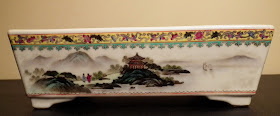 |
| Qianlong bulb pot - traditional Chinese country lake scene |
These pots, with no drain holes, usually were used as decorative dishes for forcing bulbs to bloom indoor. Some people used them as a bonsai pot, too.
On the other two sides are inscribed two Chinese poems between other red marks. I wasn't so lucky to find them on the internet, so I did not know how to translate them (yet).
 |
| Poem written on one side of Qianlong bulb pot |
 |
| Poem written on porcelain Qianlong bulb pot |
I'm sure this year bulbs will not grow in this Chinese Qianlong bulb pot because I still research about it - I am wandering when was made it and what's the meaning of poems written on its sides.
Thursday, December 9, 2010
Growing pelargoniums from seeds
Usually the pelargonium / geranium seeds are planted in January/February in order to start new plants in spring, when the winter freeze will be over. Pelargoniums / geraniums plants grown from seeds often outperform the varieties propagated from cuttings and posses excellent disease resistance and vigor properties and can tolerate high temperatures. Growing them is not so tough, but you need to be patient as they take few months to mature and bloom (flowering occurs 12 -16 weeks after sowing).
I decide to plant pelargonium seeds now because their germination it is a slow germination process. The coat of pelargonium seeds is impermeable to water and/or oxygen and if you want to have a 90-100% percent germination within two weeks after sowing, it is recommended to remove a small amount of the seed coat (scarification technique). Non-scarified seeds had a half percent of germination in the same time, but for me is more reliable. Mechanical scarification could be accomplished by cutting a small piece from seed - and I'm afraid to do it. The scarification using acids is not exactly what I'm looking for, because I'm trying to eliminate the chemicals usage for my plants. Usually the seeds commercially available are scarified with one of these methods, but I gather myself the seeds from my garden and as I already told you, I'll plant them non scarified.
This was on my "to do" list for these days. I prepared a starter mix soil with equal amounts of peat moss, vermiculite and perlite. I checked the soil PH to make sure the peat moss haven't made it too acid - and I added a bit of lime to increase PH level (ideal is somewhere between 6.5 - 7.5).
I filled the containers with germination medium to within 1 cm of the top, slightly firmed with my fingers. I watered the soil with very hot water (the peat moss is re-sterilized and absorbs the moisture), then I allowed it to drain for several hours. Separate, I soak seeds for 24 hours to start them to germinate.
I sowed the seeds in drained germinating mix and covered them (few millimeters) I prefer to plant just 3 seeds in each container to avoid transplantation issues. After sowing, I watered them thoroughly by partially submersing the containers in water until the surface becomes wet.
I removed the containers from the water and allowed them to drain then I put the pots in a plastic dome (a plastic seed tray covered with a plastic lid) to be sure that I maintain a uniform moisture level throughout the germination period. I will eliminate this plastic dome when the first saplings will appear (perhaps 3-4 weeks) and I will place them under a fluorescent light or near a sunny window (12 hours daily). All this period I will keep them indoor at an average 20 degrees Celsius.
Some people preferred another method : to start some of the seed on moist paper towels in freezer bags (in order to avoid the dried out during germination). I used this method with some of the moringa seeds, which are way bigger than pelargonium seeds. The advantage of germinating on moist paper towels is that you pot only the seed that germinates - but you can lose some of them when planting in potting mix (you should be very carefully when planting pelargonium saplings because their stems break easily)
A serious problem, that can destroy the seeds during germination and the young plants, is damping-off, which is caused by various types of fungi. To discourage damping-off, I use new containers for starting seeds, which have adequate drainage (previously used containers should be washed well and disinfected).
I added Hydrogen peroxide (diluted) to the water and when I soaked the seeds and the pots - it is very useful in control mold and fungus on plants and in the soil.
Well done! I will make another post about them once the seeds would germinate and the saplings will show first true set of leaves.
 |
| Planting pelargonium seeds in sterilized germination soil mix |
I decide to plant pelargonium seeds now because their germination it is a slow germination process. The coat of pelargonium seeds is impermeable to water and/or oxygen and if you want to have a 90-100% percent germination within two weeks after sowing, it is recommended to remove a small amount of the seed coat (scarification technique). Non-scarified seeds had a half percent of germination in the same time, but for me is more reliable. Mechanical scarification could be accomplished by cutting a small piece from seed - and I'm afraid to do it. The scarification using acids is not exactly what I'm looking for, because I'm trying to eliminate the chemicals usage for my plants. Usually the seeds commercially available are scarified with one of these methods, but I gather myself the seeds from my garden and as I already told you, I'll plant them non scarified.
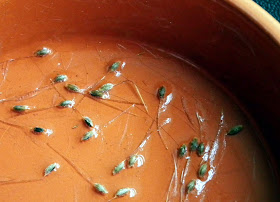 |
| Soaked Pelargonium Coconut seeds |
 |
| Frensham Lemon seed |
This was on my "to do" list for these days. I prepared a starter mix soil with equal amounts of peat moss, vermiculite and perlite. I checked the soil PH to make sure the peat moss haven't made it too acid - and I added a bit of lime to increase PH level (ideal is somewhere between 6.5 - 7.5).
 |
| Planting pelargonium Frensham Lemon seeds |
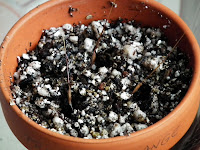 |
| Planting Prince of Orange seeds |
I filled the containers with germination medium to within 1 cm of the top, slightly firmed with my fingers. I watered the soil with very hot water (the peat moss is re-sterilized and absorbs the moisture), then I allowed it to drain for several hours. Separate, I soak seeds for 24 hours to start them to germinate.
I sowed the seeds in drained germinating mix and covered them (few millimeters) I prefer to plant just 3 seeds in each container to avoid transplantation issues. After sowing, I watered them thoroughly by partially submersing the containers in water until the surface becomes wet.
 |
| Planting pelargonium seeds in drained germination mix |
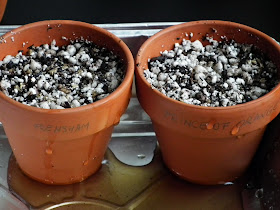 |
| Watering pelargonium seeds sowed in sterilized germination mix |
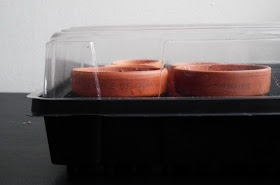 |
Germinating scented pelargonium seeds in plastic dome. |
A serious problem, that can destroy the seeds during germination and the young plants, is damping-off, which is caused by various types of fungi. To discourage damping-off, I use new containers for starting seeds, which have adequate drainage (previously used containers should be washed well and disinfected).
I added Hydrogen peroxide (diluted) to the water and when I soaked the seeds and the pots - it is very useful in control mold and fungus on plants and in the soil.
Well done! I will make another post about them once the seeds would germinate and the saplings will show first true set of leaves.

